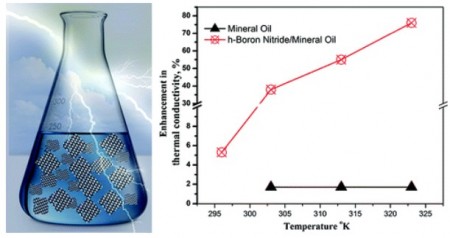Feb
3
A More Efficient Way to Move Heat
February 3, 2012 | Leave a Comment
Rice University’s materials scientist Pulickel Ajayan with graduate student Jaime Taha-Tijerina and postdoctoral researcher Tharangattu Narayanan, with help from Matteo Pasquali, professor of chemical and biomolecular engineering and of chemistry, have created a nano-infused oil that could greatly enhance the ability of devices as large as electrical transformers and as small as microelectronic components to shed away excess heat.
The team’s research appears in the American Chemical Society journal ACS Nano. Lab results show the new oil additive could raise the efficiency of such transfer mediums by as much as 80 percent using an environmentally friendly base material.

The Rice Team's h-BN Comparative Results Graph. See the paper linked above for more details. Click image for the largest view.
While we may be interested in moving heat efficiently, the Rice team focused on electrical transformers. Electrical transformers step voltage up or down and in doing so the wire resistance within causes heat to build up. Currently most transformers are filled with fluids that cool and insulate the core and windings inside, as well as components that must remain separated from each other to keep voltage from leaking or shorting out.
The team has discovered that a very tiny amount of hexagonal boron nitride (h-BN) particles, which are two-dimensional cousins to carbon-based graphene, suspended in standard transformer mineral oils are highly efficient at removing heat from a system.
Narayanan said, “We don’t need a large amount of h-BN. We found that 0.1 weight percentage of h-BN in transformer oil enhances it by nearly 80 percent.” This news will light up a lot of heat management folks worldwide.
Taha-Tijerina adds to the depth of the discovery’s value with, “And at 0.01 weight percentage, the enhancement was around 9 percent. Even with a very low amount of material, we can enhance the fluids without compromising the electrical insulating properties.”
The background focuses on Taha-Tijerina, who was employed by an electrical transformer manufacturer in Mexico before coming to Rice, explains others working on similar compounds are experimenting with particles of aluminum, copper oxide and titanium oxide, but none of the compounds has the combination of qualities exhibited by h-BN.
Narayanan explains the technical details of h-BN particles that are about 600 nanometers wide and up to five atomic layers thick, disperse well in oil and, unlike highly electrically conductive graphene, are highly resistant to electricity. With help from Pasquali the team determined that the important quality of the oil’s viscosity is minimally affected by the presence of the new h-BN nanoparticle fillers.
Professor Ajayan who is Rice’s Benjamin M. and Mary Greenwood Anderson Professor in Mechanical Engineering and Materials Science and of Chemistry said, “Our research shows that with new materials and innovative approaches, we can add enormous value to applications that exist today in industry. Thermal management is a big issue in industry, but the right choice of materials is important; for transformer cooling, one needs dispersants in oils that take heat away, yet remain electrically insulating. Moreover, the two-dimensional nature of the fillers keeps them stable in oils without settling down for long periods of time.”
The Rice press release winds up adding Guanhui Gao, a visiting scholar in Ajayan’s lab; senior Matthew Rohde; and graduate student Dmitri Tsentalovich as team members.
Obviously the team has worked on the project in view of the perspectives of the team members and the interests of the supportive funding. But the huge improvement of heat transfer is going to affect a much wider range of interests than electricity alone.
Moving heat, or conducting it, is an engineering challenge of getting as much as possible from the source to the work. The less that’s lost the better. The Rice University team’s discovery of a particle adding so much efficiency will stimulate a lot more research into other fluids and solids. The result should be less fuel to drive the same amount of work.
The innovation that earns the applause is connecting the aspects of graphene to the h-BN molecule and particles finding a new result. It’s a clue for more discoveries born of close observation and creative thought.

